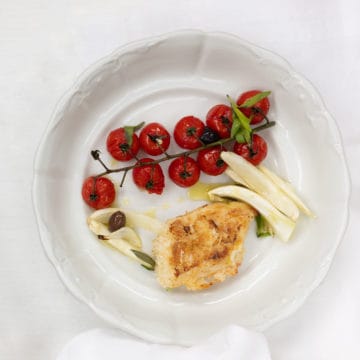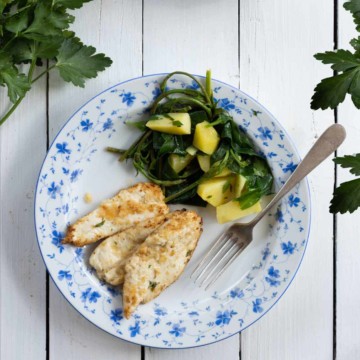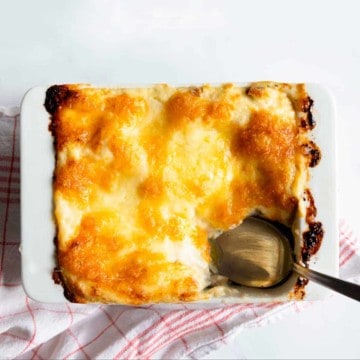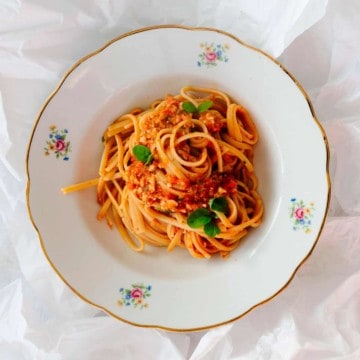
Ossobuco with saffron risotto is a fixed star of northern Italian cuisine and one of the best fall comfort food dishes ever! The slow-braised leg of veal is traditionally combined with saffron risotto. Two intense flavors that harmonize wonderfully.
ITALIAN STYLE OF COOKING
Saffron risotto is, by the way, the only rice dish or primo piatto that can be served with ossobuco. Pasta is frowned upon, because in Italian cuisine - with a few exceptions - no dishes high in carbohydrates and protein are served together. Usually pasta, risotto and co. are served as primi piatti and meat or fish as secondi piatti, accompanied by vegetables, potatoes or bread. However, meat or fish are very much allowed in the sauces of the primi piatti, think of the famous "Bolognese". Polenta is also an excellent accompaniment to ossobuco.

FROM 1 TO 12
Italy's rice cultivation begins with a noble anecdote. In 1475, for example, the Duke of Milan is said to have given a sack of rice grains to the Dukes of Este of Ferrara. He assured them that after a good cultivation they would harvest 12 sacks of rice. In fact, the new grain from Asia flourished magnificently in the swampy Po Valley. And the "1 to 12" rule was proved true. In just a few years, the areas under cultivation multiplied. Soon rice, together with corn, was the most important staple food in northern Italy.
📖 Recipe

Ossobuco with saffron risotto
Equipment
- 1 pan
- 1 pot
- 1 schale
Ingredients
Ossibuchi
- 4 Ossibuchi , from veal
- salt
- pepper, freshly ground
- 3 tablespoon flour
- 30 g butter
- 50 ml wine, white
- 1 onion
- 1 stalk celery
- 2 carrots
- 2 tablespoon tomato purée
- approx. ½ l broth, vegetable
Gremolata
- 1 clove garlic
- 1 lemon, untreated
- 1 small bunch parsley
Risotto alla milanese
- 350 g rice, risotto rice
- 30 g butter
- olive oil
- ¼ onion
- 40 g beef bone marrow
- 1 l soup, clear soup
- 1 packet saffron, 1-2 g filaments
- ½ glass wine, dry and red, optional
- 6 tablespoon Parmesan, grated
- salt, to taste
Instructions
- Pound the ossibuchi. Make cuts in the edges to prevent the meat from curling during frying. Salt and pepper the ossibuchi and coat in flour. Tap off excess flour and add a little more salt. Heat a large frying pan – preferably metal. Add enough fat to the pan and fry the ossibuchi over a high heat for 4 minutes per side. Then slowly pour in the wine and let it evaporate. Remove the ossibuchi from the pan and set aside.
- Immediately fry the cleaned and coarsely chopped onion, carrots and celery in the juices. Season with salt and pepper. Pour in 1 ladle of broth and simmer for 5 minutes until the juices have reduced. Reduce heat. Return ossibuchi to the pan.
- Add tomato purée to a little broth (it dissolves better in warm liquid) and mix with the rest of the broth. Pour the liquid into the pan. Cover the pan and let it simmer gently for a good hour. The meat is good when it comes off the bone easily.
- Meanwhile, for the germolata, finely chop the garlic and parsley and mix with the grated lemon zest. Cover and leave to stand.
- For the risotto warm the soup. Crush the saffron and dissolve it in a little warm soup. Heat the rest of the soup.
- Put half the butter, a little oil, the finely chopped onion and the chopped marrow into a pot. Sauté over a medium heat, stirring. Add the rice and mix well until it has a shiny coating. Pour in the wine and let it reduce. Now add the soup gradually with a ladle so that the rice always has liquid to absorb. Stir regularly.
- For most types of risotto rice, the cooking time is about 18 minutes (please note the information on the package). When the rice has cooked for 15 minutes, add the dissolved saffron. Finish cooking the rice, stirring constantly. It should still be firm to the bite.
- Remove the risotto from the cooker. Mix in the remaining butter and the grated Parmesan until melted. Season with salt. When the meat is tender, you can also add some freshly ground pepper to round it off. You can strain or purée the sauce as desired. Serve the ossibuchi on pre-heated plates with the gremolada and creamy risotto.
Nutrition
Buon appetito!






Leave a Reply